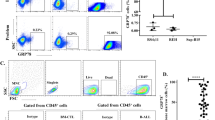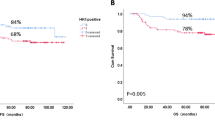Abstract
Background
Glucose-regulated protein (GRP) 78/immunoglobulin heavy chain binding protein (BiP) is a member of the endoplasmic reticulum chaperone family, and its role in various types of human malignancies has recently been investigated. However, the clinicopathological characteristics of GRP78/BiP in advanced thymic carcinoma (ATC) remain unknown. We aimed to examine the relationship between GRP78/BiP expression and the clinical outcomes of ATC patients.
Methods
Thirty-four patients with ATC receiving combination chemotherapy at three institutions between April 1998 and April 2014 were enrolled in this study. We retrospectively collected patient characteristics such as therapeutic efficacy, pathological findings, and survival data from their medical records. We performed immunohistochemical analysis to evaluate the expression of GRP78/BiP in tumor specimens obtained from surgical resection or biopsy.
Results
This study included 21 men (68%) and 13 women (32%) with a median age of 62 years (range 36–75 years). GRP78/BiP overexpression was observed in 65% of the patients (22 of 34 patients). There was no correlation between GRP78/BiP expression and any patient characteristic. Patients with a high level of GRP78/BiP expression had significantly longer overall survival (OS) compared to those with a low level (46.2 vs. 16.8 months, p = 0.04). Multivariate analysis demonstrated that a high level of GRP78/BiP expression was an independent prognostic factor for prolonged OS.
Conclusions
Our findings indicate that the overexpression of GRP78/BiP is a novel predictor of favorable outcomes in patients with ATC who receive combination chemotherapy.


Similar content being viewed by others
References
Kelly RJ, Petrini I, Rajan A et al (2011) Thymic malignancies: from clinical management to targeted therapies. J Clin Oncol 29(36):4820–4827. doi:10.1200/jco.2011.36.0487
Engels EA, Pfeiffer RM (2003) Malignant thymoma in the United States: demographic patterns in incidence and associations with subsequent malignancies. Int J Cancer 105(4):546–551. doi:10.1002/ijc.11099
Lemma GL, Lee JW, Aisner SC et al (2011) Phase II study of carboplatin and paclitaxel in advanced thymoma and thymic carcinoma. J Clin Oncol 29(15):2060–2065. doi:10.1200/jco.2010.32.9607
Kondo K, Monden Y (2003) Therapy for thymic epithelial tumors: a clinical study of 1,320 patients from Japan. Ann Thorac Surg 76(3):878–884 (discussion 884–875)
Giaccone G, Ardizzoni A, Kirkpatrick A et al (1996) Cisplatin and etoposide combination chemotherapy for locally advanced or metastatic thymoma. A phase II study of the European Organization for Research and Treatment of Cancer Lung Cancer Cooperative Group. J Clin Oncol 14(3):814–820
Agatsuma T, Koizumi T, Kanda S et al (2011) Combination chemotherapy with doxorubicin, vincristine, cyclophosphamide, and platinum compounds for advanced thymic carcinoma. J Thorac Oncol 6(12):2130–2134. doi:10.1097/JTO.0b013e31822e71c0
Lee AS (2007) GRP78 induction in cancer: therapeutic and prognostic implications. Cancer Res 67(8):3496–3499. doi:10.1158/0008-5472.can-07-0325
Ma Y, Hendershot LM (2004) The role of the unfolded protein response in tumour development: friend or foe? Nat Rev Cancer 4(12):966–977. doi:10.1038/nrc1505
Hendershot LM (2004) The ER function BiP is a master regulator of ER function. Mt Sinai J Med 71(5):289–297
Zhang J, Jiang Y, Jia Z et al (2006) Association of elevated GRP78 expression with increased lymph node metastasis and poor prognosis in patients with gastric cancer. Clin Exp Metastasis 23(7–8):401–410. doi:10.1007/s10585-006-9051-9
Dong D, Ni M, Li J et al (2008) Critical role of the stress chaperone GRP78/BiP in tumor proliferation, survival, and tumor angiogenesis in transgene-induced mammary tumor development. Cancer Res 68(2):498–505. doi:10.1158/0008-5472.can-07-2950
Lee E, Nichols P, Spicer D et al (2006) GRP78 as a novel predictor of responsiveness to chemotherapy in breast cancer. Cancer Res 66(16):7849–7853. doi:10.1158/0008-5472.can-06-1660
Daneshmand S, Quek ML, Lin E et al (2007) Glucose-regulated protein GRP78 is up-regulated in prostate cancer and correlates with recurrence and survival. Hum Pathol 38(10):1547–1552. doi:10.1016/j.humpath.2007.03.014
Fu W, Wu X, Li J et al (2010) Upregulation of GRP78 in renal cell carcinoma and its significance. Urology 75(3):603–607. doi:10.1016/j.urology.2009.05.007
Langer R, Feith M, Siewert JR et al (2008) Expression and clinical significance of glucose regulated proteins GRP78 (BiP) and GRP94 (GP96) in human adenocarcinomas of the esophagus. BMC Cancer 8:70. doi:10.1186/1471-2407-8-70
Uramoto H, Sugio K, Oyama T et al (2005) Expression of endoplasmic reticulum molecular chaperone Grp78 in human lung cancer and its clinical significance. Lung Cancer 49(1):55–62. doi:10.1016/j.lungcan.2004.12.011
Thornton M, Aslam MA, Tweedle EM et al (2013) The unfolded protein response regulator GRP78 is a novel predictive biomarker in colorectal cancer. Int J Cancer 133(6):1408–1418. doi:10.1002/ijc.28137
Koga K, Matsuno Y, Noguchi M et al (1994) A review of 79 thymomas: modification of staging system and reappraisal of conventional division into invasive and non-invasive thymoma. Pathol Int 44(5):359–367
Travis W, Brambilla E, Muller-Hermelink H et al (2004) World Health Organization Classification of Tumours: pathology and genetics. Tumours of the lung, pleura, thymus and heart. IARC, Lyon
Miura Y, Kaira K, Sakurai R et al. (2016) Prognostic impact of class III β-tubulin and topoisomerase-II in patients with advanced thymic carcinoma who received combination chemotherapy, including taxanes or topoisomerase-II inhibitors. Oncol Lett (in press)
Lee E, Nichols P, Groshen S et al (2011) GRP78 as potential predictor for breast cancer response to adjuvant taxane therapy. Int J Cancer 128(3):726–731. doi:10.1002/ijc.25370
Yerushalmi R, Raiter A, Nalbandyan K et al (2015) Cell surface GRP78: a potential marker of good prognosis and response to chemotherapy in breast cancer. Oncol Lett 10(4):2149–2155. doi:10.3892/ol.2015.3579
Wei PL, Kuo LJ, Wang W et al (2012) Silencing of glucose-regulated protein 78 (GRP78) enhances cell migration through the upregulation of vimentin in hepatocellular carcinoma cells. Ann Surg Oncol 19(Suppl 3):S572–S579. doi:10.1245/s10434-011-2055-y
Jamora C, Dennert G, Lee AS (1996) Inhibition of tumor progression by suppression of stress protein GRP78/BiP induction in fibrosarcoma B/C10ME. Proc Natl Acad Sci USA 93(15):7690–7694
Fu Y, Lee AS (2006) Glucose regulated proteins in cancer progression, drug resistance and immunotherapy. Cancer Biol Ther 5(7):741–744
Pyrko P, Schonthal AH, Hofman FM et al (2007) The unfolded protein response regulator GRP78/BiP as a novel target for increasing chemosensitivity in malignant gliomas. Cancer Res 67(20):9809–9816. doi:10.1158/0008-5472.can-07-0625
Tanimoto R, Sakaguchi M, Abarzua F et al (2010) Down-regulation of BiP/GRP78 sensitizes resistant prostate cancer cells to gene-therapeutic overexpression of REIC/Dkk-3. Int J Cancer 126(7):1562–1569. doi:10.1002/ijc.24764
Davidson DJ, Haskell C, Majest S et al (2005) Kringle 5 of human plasminogen induces apoptosis of endothelial and tumor cells through surface-expressed glucose-regulated protein 78. Cancer Res 65(11):4663–4672. doi:10.1158/0008-5472.can-04-3426
Burikhanov R, Zhao Y, Goswami A et al (2009) The tumor suppressor Par-4 activates an extrinsic pathway for apoptosis. Cell 138(2):377–388. doi:10.1016/j.cell.2009.05.022
Verfaillie T, Garg AD, Agostinis P (2013) Targeting ER stress induced apoptosis and inflammation in cancer. Cancer Lett 332(2):249–264. doi:10.1016/j.canlet.2010.07.016
Kaira K, Toyoda M, Shimizu A et al (2016) Decreasing expression of glucose-regulated protein GRP78/BiP as a significant prognostic predictor in patients with advanced laryngeal squamous cell carcinoma. Head Neck 38(10):1539–1544. doi:10.1002/hed.24471
Kaira K, Toyoda M, Shimizu A et al (2016) Prognostic significance of GRP78/BiP expression in patients with stage III/IV hypopharyngeal squamous cell carcinoma. Neoplasma 63(3):477–483. doi:10.4149/319_151002n513
Gifford JB, Huang W, Zeleniak AE et al (2016) Expression of GRP78, master regulator of the unfolded protein response, increases chemoresistance in pancreatic ductal adenocarcinoma. Mol Cancer Ther 15(5):1043–1052. doi:10.1158/1535-7163.mct-15-0774
Cerezo M, Lehraiki A, Millet A et al (2016) Compounds triggering ER stress exert anti-melanoma effects and overcome BRAF inhibitor resistance. Cancer Cell. doi:10.1016/j.ccell.2016.04.013
Acknowledgements
The authors would like to thank Dr. Akira Mogi, Department of General Surgical Science, Dr. Kimihiro Shimizu, Department of Thoracic Visceral Organ Surgery, and Dr. Masataka Maeno, Department of Medicine and Biological Science, for data collection. We would like to show our appreciation for technical assistance with immunohistochemical analysis to the staff in the pathology departments of the Gunma University Hospital, Gunma Prefectural Cancer Center, and National Hospital Organization Shibukawa Medical Center. This work was supported in part by grant 26461154 (KK) from the Ministry of Education, Culture, Sports, Science and Technology, Japan.
Author information
Authors and Affiliations
Corresponding author
Ethics declarations
Conflict of interest
The authors declare that they have no conflicts of interest.
Ethical approval
All procedures performed in studies involving human participants were carried out in accordance with the ethical standards of the institutional and/or national research committee and in accordance with the 1964 Helsinki Declaration and its later amendments or comparable ethical standards. For this type of study, formal consent is not required.
About this article
Cite this article
Miura, Y., Kaira, K., Sakurai, R. et al. High expression of GRP78/BiP as a novel predictor of favorable outcomes in patients with advanced thymic carcinoma. Int J Clin Oncol 22, 872–879 (2017). https://doi.org/10.1007/s10147-017-1142-x
Received:
Accepted:
Published:
Issue Date:
DOI: https://doi.org/10.1007/s10147-017-1142-x




